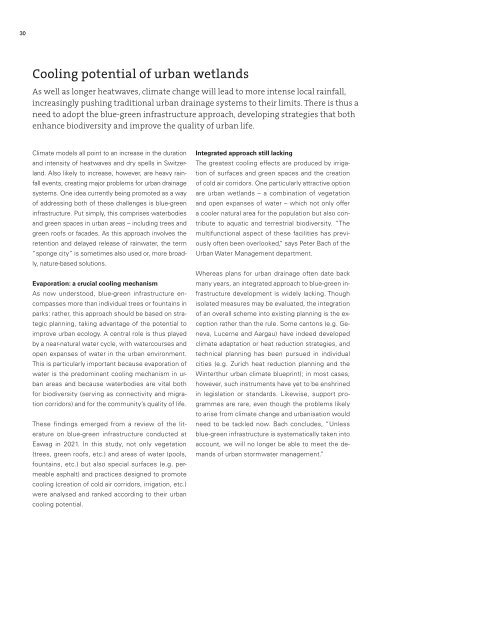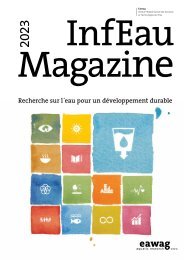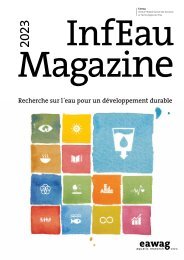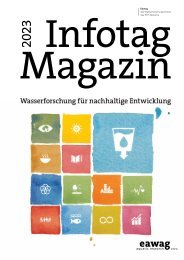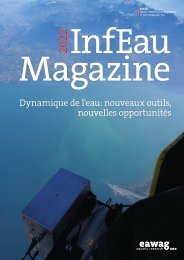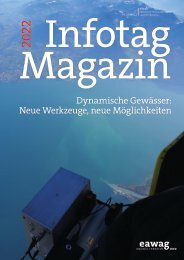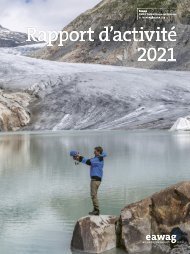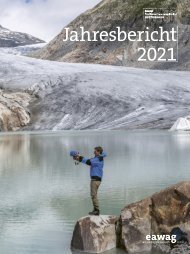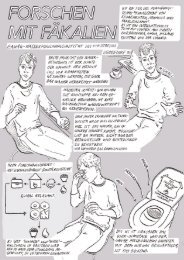Eawag Annual Report 2021
The Annual Report gives a wide-ranging account of current Eawag projects. It is published in English and German, and since 2013 also in French.
The Annual Report gives a wide-ranging account of current Eawag projects. It is published in English and German, and since 2013 also in French.
Create successful ePaper yourself
Turn your PDF publications into a flip-book with our unique Google optimized e-Paper software.
30<br />
Cooling potential of urban wetlands<br />
As well as longer heatwaves, climate change will lead to more intense local rainfall,<br />
increasingly pushing traditional urban drainage systems to their limits. There is thus a<br />
need to adopt the blue-green infrastructure approach, developing strategies that both<br />
enhance biodiversity and improve the quality of urban life.<br />
Climate models all point to an increase in the duration<br />
and intensity of heatwaves and dry spells in Switzerland.<br />
Also likely to increase, however, are heavy rainfall<br />
events, creating major problems for urban drainage<br />
systems. One idea currently being promoted as a way<br />
of addressing both of these challenges is blue-green<br />
infrastructure. Put simply, this comprises waterbodies<br />
and green spaces in urban areas – including trees and<br />
green roofs or facades. As this approach involves the<br />
retention and delayed release of rainwater, the term<br />
“sponge city” is sometimes also used or, more broadly,<br />
nature-based solutions.<br />
Evaporation: a crucial cooling mechanism<br />
As now understood, blue-green infrastructure encompasses<br />
more than individual trees or fountains in<br />
parks: rather, this approach should be based on strategic<br />
planning, taking advantage of the potential to<br />
improve urban ecology. A central role is thus played<br />
by a near-natural water cycle, with watercourses and<br />
open expanses of water in the urban environment.<br />
This is particularly important because evaporation of<br />
water is the predominant cooling mechanism in urban<br />
areas and because waterbodies are vital both<br />
for biodiversity (serving as connectivity and migration<br />
corridors) and for the community’s quality of life.<br />
These findings emerged from a review of the literature<br />
on blue-green infrastructure conducted at<br />
<strong>Eawag</strong> in <strong>2021</strong>. In this study, not only vegetation<br />
(trees, green roofs, etc.) and areas of water (pools,<br />
fountains, etc.) but also special surfaces (e.g. permeable<br />
asphalt) and practices designed to promote<br />
cooling (creation of cold air corridors, irrigation, etc.)<br />
were analysed and ranked according to their urban<br />
cooling potential.<br />
Integrated approach still lacking<br />
The greatest cooling effects are produced by irrigation<br />
of surfaces and green spaces and the creation<br />
of cold air corridors. One particularly attractive option<br />
are urban wetlands – a combination of vegetation<br />
and open expanses of water – which not only offer<br />
a cooler natural area for the population but also contribute<br />
to aquatic and terrestrial biodiversity. “The<br />
multifunctional aspect of these facilities has previously<br />
often been overlooked,” says Peter Bach of the<br />
Urban Water Management department.<br />
Whereas plans for urban drainage often date back<br />
many years, an integrated approach to blue-green infrastructure<br />
development is widely lacking. Though<br />
isolated measures may be evaluated, the integration<br />
of an overall scheme into existing planning is the exception<br />
rather than the rule. Some cantons (e.g. Geneva,<br />
Lucerne and Aargau) have indeed developed<br />
climate adaptation or heat reduction strategies, and<br />
technical planning has been pursued in individual<br />
cities (e.g. Zurich heat reduction planning and the<br />
Winterthur urban climate blueprint); in most cases,<br />
however, such instruments have yet to be enshrined<br />
in legislation or standards. Likewise, support programmes<br />
are rare, even though the problems likely<br />
to arise from climate change and urbanisation would<br />
need to be tackled now. Bach concludes, “Unless<br />
blue-green infrastructure is systematically taken into<br />
account, we will no longer be able to meet the demands<br />
of urban stormwater management.”


